An Unmanned Aerial Vehicle (UAV)-Based Methane Quantification Method for Oil and Gas Sites
Highlights
- An unmanned aerial vehicle (UAV) equipped with a scanning–sampling tunable diode laser absorption spectroscopy (TDLAS) system was developed for CH4 emission rate quantification.
- An average methane emission rate of 1.425 kg/h was detected at eight well sites in Changqing Oilfield, China, higher than the 1.061 kg/h from ground measurements.
- Offers the oil/gas industry a better diffuse CH4 monitoring tool.
- The scanning sampling pattern can cover a large range of oil and gas well sites, improve sampling efficiency, reduce flight time and costs, and is suitable for large-scale monitoring.
Abstract
1. Introduction
2. Methods
2.1. Aircraft and Instrumentation
2.2. Study Area and Sampling Pattern
2.3. TERRA Method and Onsite Direct Measurement Method
2.4. Uncertainty Analysis
3. Result
3.1. Quantitative Results of CH4 Emissions
3.2. Uncertainty Analysis Results
4. Discussion
5. Conclusions
Author Contributions
Funding
Data Availability Statement
Acknowledgments
Conflicts of Interest
References
- IPCC. Climate Change 2023: Synthesis Report. Contribution of Working Groups I, II and III to the Sixth Assessment Report of the Intergovernmental Panel on Climate Change; Lee, H., Romero, J., Eds.; IPCC: Geneva, Switzerland, 2023; p. 184. [Google Scholar] [CrossRef]
- Liu, Y.; Paris, J.-D.; Broquet, G.; Roy, V.B.; Fernandez, T.M.; Andersen, R.; Berlanga, A.R.; Christensen, E.; Courtois, Y.; Dominok, S.; et al. Assessment of current methane emissions quantification techniques for natural gas midstream applications. Atmos. Meas. Tech. 2023, 17, 1633–1649. [Google Scholar] [CrossRef]
- Shaw, J.T.; Shah, A.; Yong, H.; Allen, G. Methods for quantifying methane emissions using unmanned aerial vehicles: A review. Phil. Trans. R. Soc. A 2021, 379, 20200450. [Google Scholar] [CrossRef] [PubMed]
- Johnson, M.R.; Tyner, D.R.; Conley, S.; Schwietzke, S.; Zavala-Araiza, D. Comparisons of airborne measurements and inventory estimates of methane emissions in the Alberta upstream oil and gas sector. Environ. Sci. Technol. 2017, 51, 13008–13017. [Google Scholar] [CrossRef] [PubMed]
- Karion, A.; Sweeney, C.; Kort, E.A.; Shepson, P.B.; Brewer, A.; Cambaliza, M.; Conley, S.A.; Davis, K.; Deng, A.; Hardesty, M.; et al. Aircraft-based estimate of total methane emissions from the Barnett shale region. Environ. Sci. Technol. 2015, 49, 8124–8131. [Google Scholar] [CrossRef]
- Corbett, A.; Smith, B. A study of a miniature TDLAS system onboard two unmanned aircraft to independently quantify methane emissions from oil and gas production assets and other industrial emitters. Atmosphere 2022, 13, 804. [Google Scholar] [CrossRef]
- Gemerek, J.R.; Ferrari, S.; Albertson, J.D. Fugitive Gas Emission Rate Estimation Using Multiple Heterogeneous Mobile Sensors. In Proceedings of the ISOCS/IEEE International Symposium on Olfaction and Electronic Nose (ISOEN), Montreal, QC, Canada, 28–31 May 2017; pp. 1–3. [Google Scholar]
- Morales, R.; Ravelid, J.; Vinkovic, K.; Korbeń, P.; Tuzson, B.; Emmenegger, L.; Chen, H.; Schmidt, M.; Humbel, S.; Brunner, D. Controlled-release experiment to investigate uncertainties in UAV-based emission quantification for methane point sources. Atmos. Meas. Tech. 2022, 15, 2177–2198. [Google Scholar] [CrossRef]
- Conley, S.; Faloona, I.; Mehrotra, S.; Suard, M.; Lenschow, D.H.; Sweeney, C.; Herndon, S.; Schwietzke, S.; Pétron, G.; Pifer, J.; et al. Application of Gauss’s theorem to quantify localized surface emissions from airborne measurements of wind and trace gases. Atmos. Meas. Tech. 2017, 10, 3345–3358. [Google Scholar] [CrossRef]
- Shah, A.; Allen, G.; Pitt, J.R.; Ricketts, H.; Williams, P.I.; Helmore, J.; Finlayson, A.; Robinson, R.; Kabbabe, K.; Hollingsworth, P.; et al. A Near-Field Gaussian plume inversion flux quantification method, applied to unmanned aerial vehicle sampling. Atmosphere 2019, 10, 396. [Google Scholar] [CrossRef]
- Kim, Y.M.; Park, M.H.; Jeong, S.; Lee, K.H.; Kim, J.Y. Evaluation of error inducing factors in unmanned aerial vehicle mounted detector to measure fugitive methane from solid waste landfill. Waste Manag. 2021, 124, 368–376. [Google Scholar] [CrossRef]
- Xu, D.; Da, H.; Wang, C.; Tang, Z.; Luan, H.; Li, J.; Zeng, Y. Methodology and uncertainty analysis of methane flux measurement for small sources based on unmanned aerial vehicles. Drones 2024, 8, 366. [Google Scholar] [CrossRef]
- Cambaliza, M.O.L.; Shepson, P.B.; Caulton, D.R.; Stirm, B.; Samarov, D.; Gurney, K.R.; Turnbull, J.; Davis, K.J.; Possolo, A.; Karion, A.; et al. Assessment of uncertainties of an aircraft-based mass balance approach for quantifying urban greenhouse gas emissions. Atmos. Chem. Phys. 2014, 14, 9029–9050. [Google Scholar] [CrossRef]
- Shi, T.; Han, Z.; Han, G.; Ma, X.; Chen, H.; Andersen, T.; Mao, H.; Chen, C.; Zhang, H.; Gong, W. Retrieving CH4-emission rates from coal mine ventilation shafts using UAV-based AirCore observations and the genetic algorithm–interior point penalty function (GA-IPPF) model. Atmos. Chem. Phys. 2022, 22, 13881–13896. [Google Scholar] [CrossRef]
- Li, Z.; Hu, H.; Shen, Y. The influence of rotor rotation of hexacopter on wind measurement accuracy. J. Exp. Fluid Mech. 2019, 33, 7–14. (In Chinese) [Google Scholar]
- Thielicke, W.; Hübert, W.; Müller, U.; Eggert, M.; Wilhelm, P. Towards accurate and practical drone-based wind measurements with an ultrasonic anemometer. Atmos. Meas. Tech. 2021, 14, 1303–1318. [Google Scholar] [CrossRef]
- Hedworth, H.A.; Sayahi, T.; Kelly, K.E.; Saad, T. The effectiveness of drones in measuring particulate matter. J. Aerosol Sci. 2021, 152, 105702. [Google Scholar] [CrossRef]
- Suchanek, G.; Filipek, R.; Goła’s, A. Design and implementation of a particulate matter measurement system for energy efficient searching of air pollution sources using a multirotor robot. Energies 2023, 16, 2959. [Google Scholar] [CrossRef]
- Gordon, M.; Li, S.-M.; Staebler, R.; Darlington, A.; Hayden, K.; O’BRien, J.; Wolde, M. Determining air pollutant emission rates based on mass balance using airborne measurement data over the Alberta oil sands operations. Atmos. Meas. Tech. 2015, 8, 3745–3765. [Google Scholar] [CrossRef]
- Fathi, S.; Gordon, M.; Makar, P.A.; Akingunola, A.; Darlington, A.; Liggio, J.; Hayden, K.; Li, S.-M. Evaluating the impact of storage-and-release on aircraft-based mass-balance methodology using a regional air-quality model. Atmos. Chem. Phys. 2021, 21, 15461–15491. [Google Scholar] [CrossRef]
- Bell, C.S.; Vaughn, T.L.; Zimmerle, D.; Herndon, S.C.; Yacovitch, T.I.; Heath, G.A.; Pétron, G.; Edie, R.; Field, R.A.; Murphy, S.M.; et al. Comparison of methane emission estimates from multiple measurement techniques at natural gas production pads. Elem. Sci. Anth. 2017, 5, 79. [Google Scholar] [CrossRef]
- Jia, W.; Jia, P.; Gu, L.; Ren, L.; Zhang, Y.; Chen, H.; Wu, X.; Feng, W.; Cai, J. Quantification of methane emissions from typical natural gas stations using on-site measurement technology. J. Pipeline Sci. Eng. 2025, 5, 100229. [Google Scholar] [CrossRef]
- Salman, C.A.; Thorina, E.; Yan, J. Uncertainty and influence of input parameters and assumptions on the design and analysis of thermochemical waste conversion processes: A stochastic approach. Energy Convers. Manag. 2020, 214, 112867. [Google Scholar] [CrossRef]
- Vinković, K.; Andersen, T.; de Vries, M.; Kers, B.; van Heuven, S.; Peters, W.; Hensen, A.; van den Bulk, P.; Chen, H. Evaluating the use of an Unmanned Aerial Vehicle (UAV)-based active AirCore system to quantify methane emissions from dairy cows. Sci. Total Environ. 2022, 831, 154898. [Google Scholar] [CrossRef] [PubMed]
- Erland, B.M.; Adams, C.; Darlington, A.; Smith, M.L.; Thorpe, A.K.; Wentworth, G.R.; Conley, S.; Liggio, J.; Li, S.-M.; Miller, C.E.; et al. Comparing airborne algorithms for greenhouse gas flux measurements over the Alberta oil sands. Atmos. Meas. Tech. 2022, 15, 5841–5859. [Google Scholar] [CrossRef]
- Andersen, T.; Vinkovic, K.; de Vries, M.; Kers, B.; Necki, J.; Swolkien, J.; Roiger, A.; Peters, W.; Chen, H. Quantifying methane emissions from coal mining ventilation shafts using an unmanned aerial vehicle (UAV)-based active AirCore system. Atmos. Environ. X 2021, 12, 100135. [Google Scholar] [CrossRef]
- Yang, S.; Talbot, R.W.; Frish, M.B.; Golston, L.M.; Aubut, N.F.; Zondlo, M.A.; Gretencord, C.; McSpiritt, J. Natural gas fugitive leak detection using an unmanned aerial vehicle: Measurement system description and mass balance approach. Atmosphere 2018, 9, 383. [Google Scholar] [CrossRef]
- Dooley, J.F.; Herndon, S.C.; Roscioli, J.R.; Worsnop, D.R.; Kolb, C.E. A new aerial approach for quantifying and attributing methane emissions: Implementation and validation. Atmos. Meas. Tech. 2024, 17, 5091–5110. [Google Scholar] [CrossRef]
- Euler, J.; Stryk, O. Optimized vehicle-specific trajectories for cooperative process estimation by sensor-equipped UAVs. In Proceedings of the 2017 IEEE International Conference on Robotics and Automation (ICRA), Singapore, 29 May–3 June 2017; pp. 3397–3403. [Google Scholar]
- Wong, G.; Wang, H.; Park, M.; Park, J.; Ahn, J.-Y.; Sung, M.; Choi, J.; Park, T.; Ban, J.; Kang, S.; et al. Optimizing an airborne mass-balance methodology for accurate emission rate quantification of industrial facilities: A case study of industrial facilities in South Korea. Sci. Total Environ. 2024, 912, 169204. [Google Scholar] [CrossRef]
- Fosco, D.; De Molfetta, M.; Renzulli, P.A.; Notarnicola, B.; Astuto, F. High-Precision Methane Emission Quantification Using UAVs and Open-Path Technology. Methane 2025, 4, 15. [Google Scholar] [CrossRef]
- Department of Climate Change, National Development and Reform Commission, China. Research on China’s Greenhouse Gas Inventory: 2005; China Environmental Press: Beijing, China, 2014. [Google Scholar]
- Xue, M.; Li, X.C.; Zhao, Y.W.; Cao, D.D.; Cui, X.Y.; Liu, G.Q.; Ding, Q. Methane emissions from shale gas production sites in southern Sichuan, China: A field trial of methods. Adv. Clim. Change Res. 2023, 14, 624–631. [Google Scholar] [CrossRef]
- Golston, L.M.; Aubut, N.F.; Frish, M.B.; Yang, S.; Talbot, R.W.; Gretencord, C.; McSpiritt, J.; Zondlo, M.A. Natural gas fugitive leak detection using an unmanned aerial vehicle: Localization and quantification of emission rate. Atmosphere 2018, 9, 333. [Google Scholar] [CrossRef]

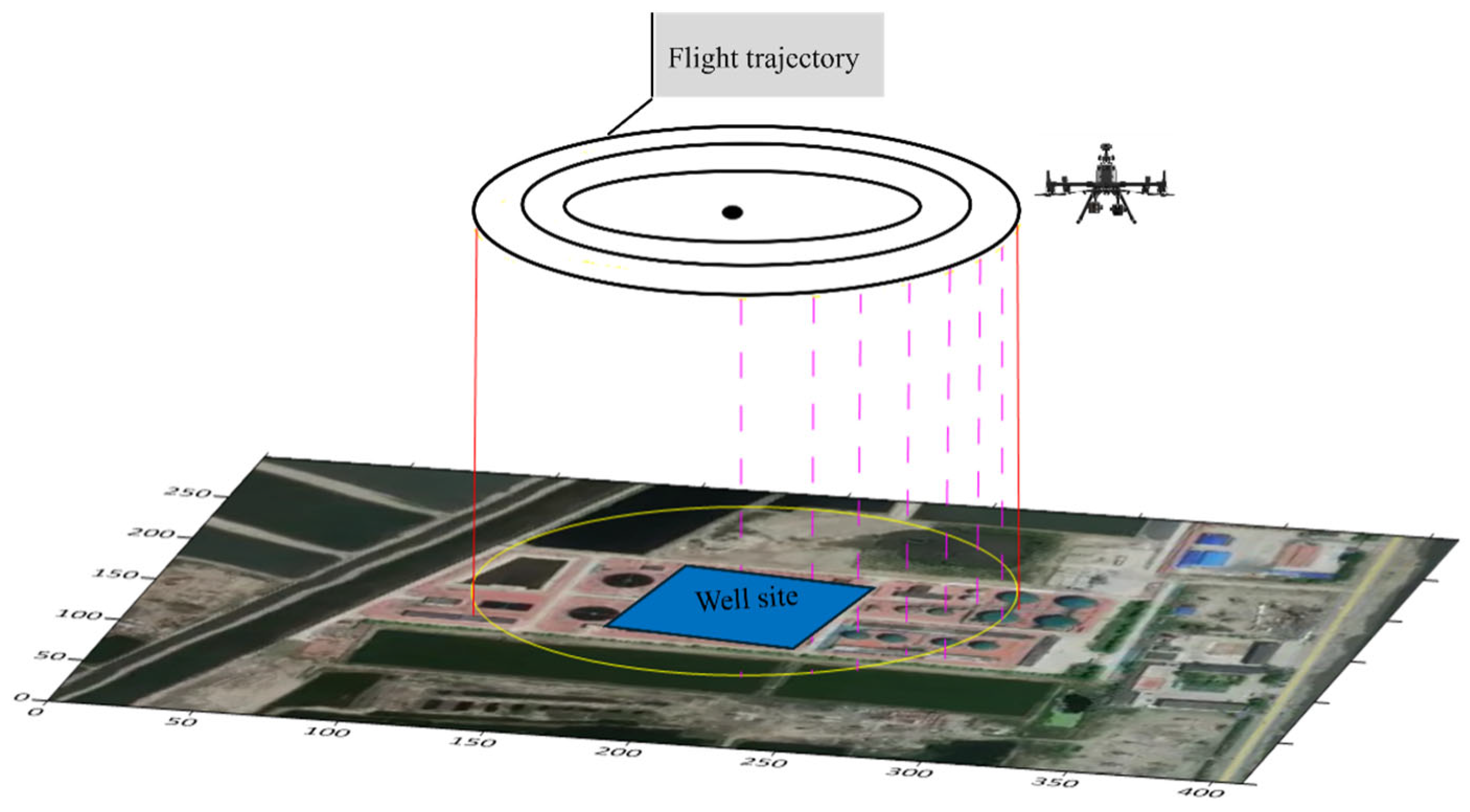
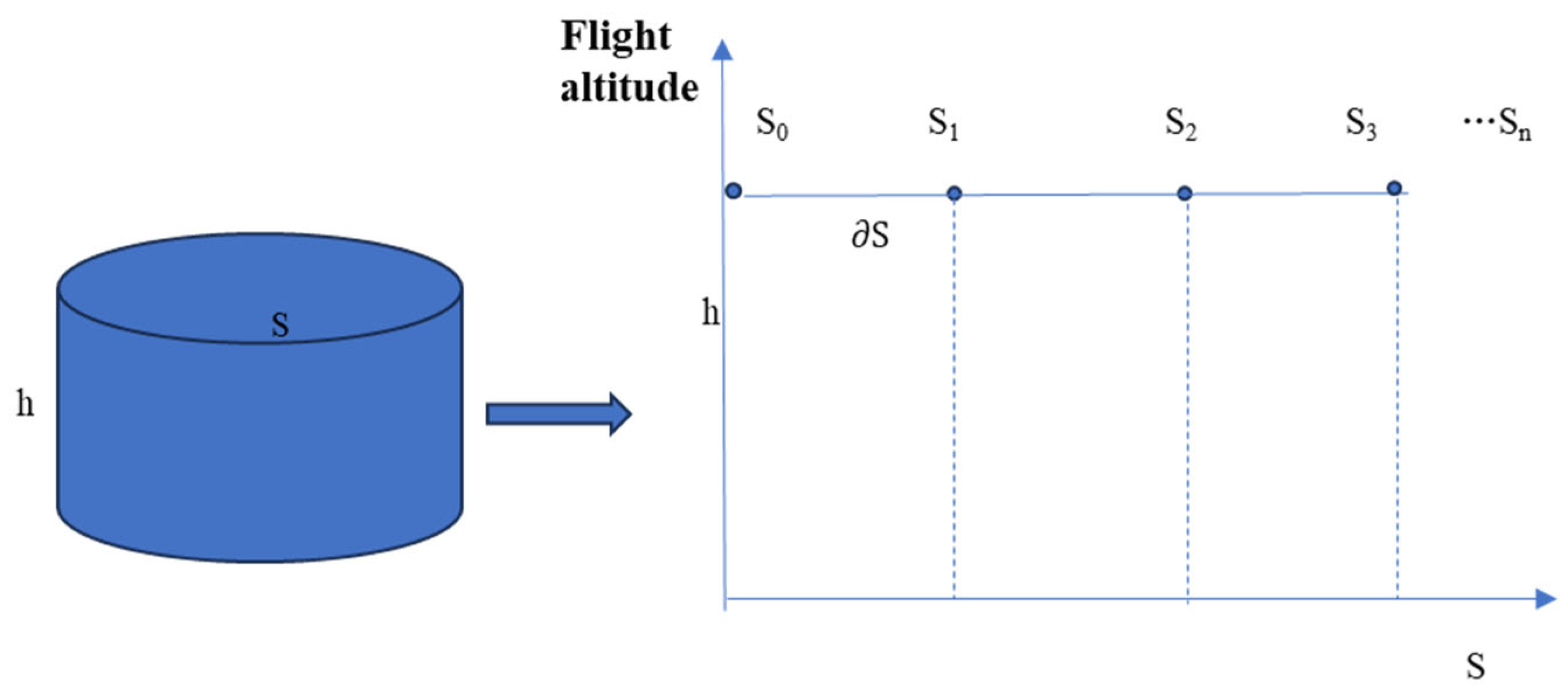

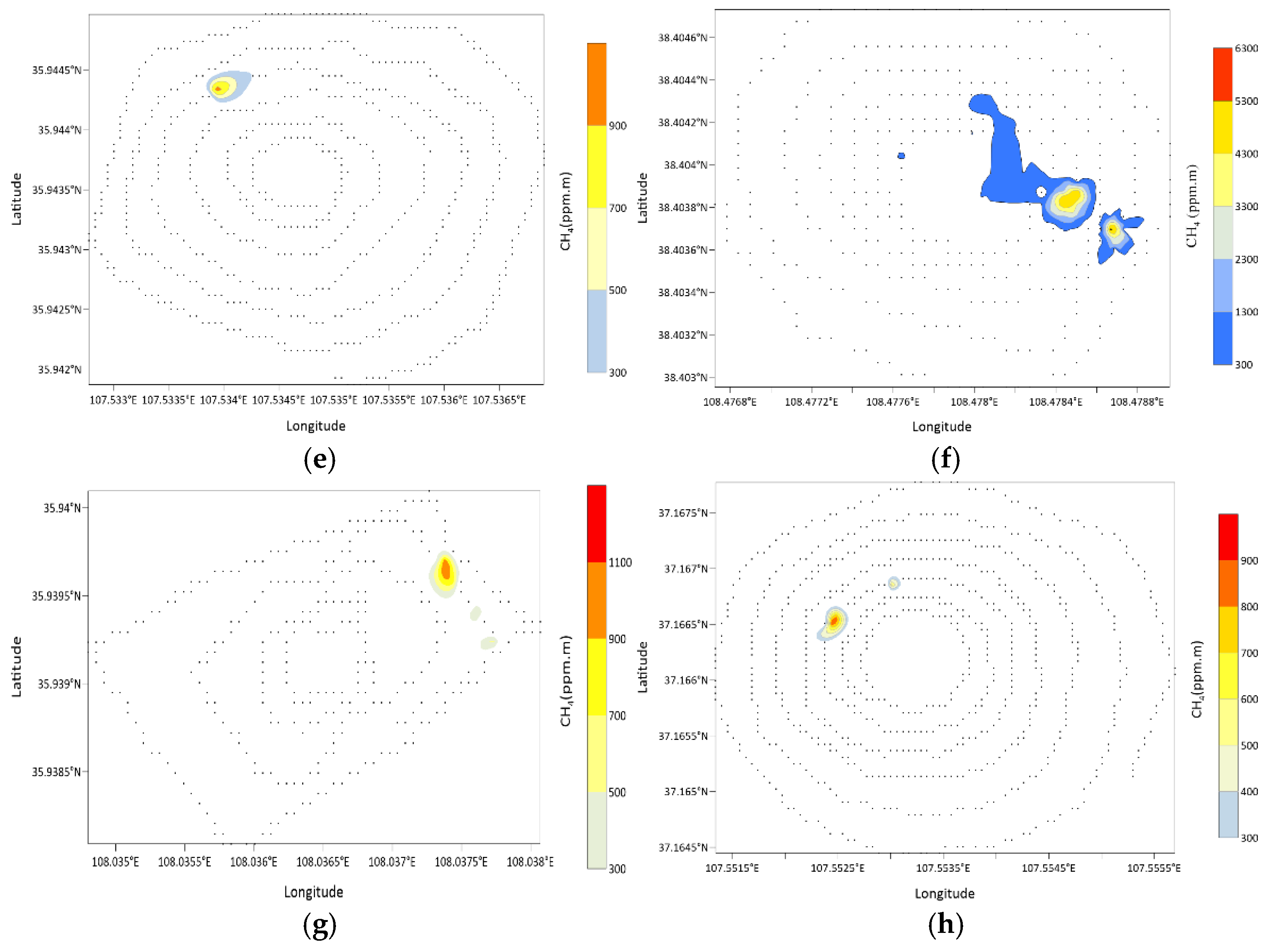

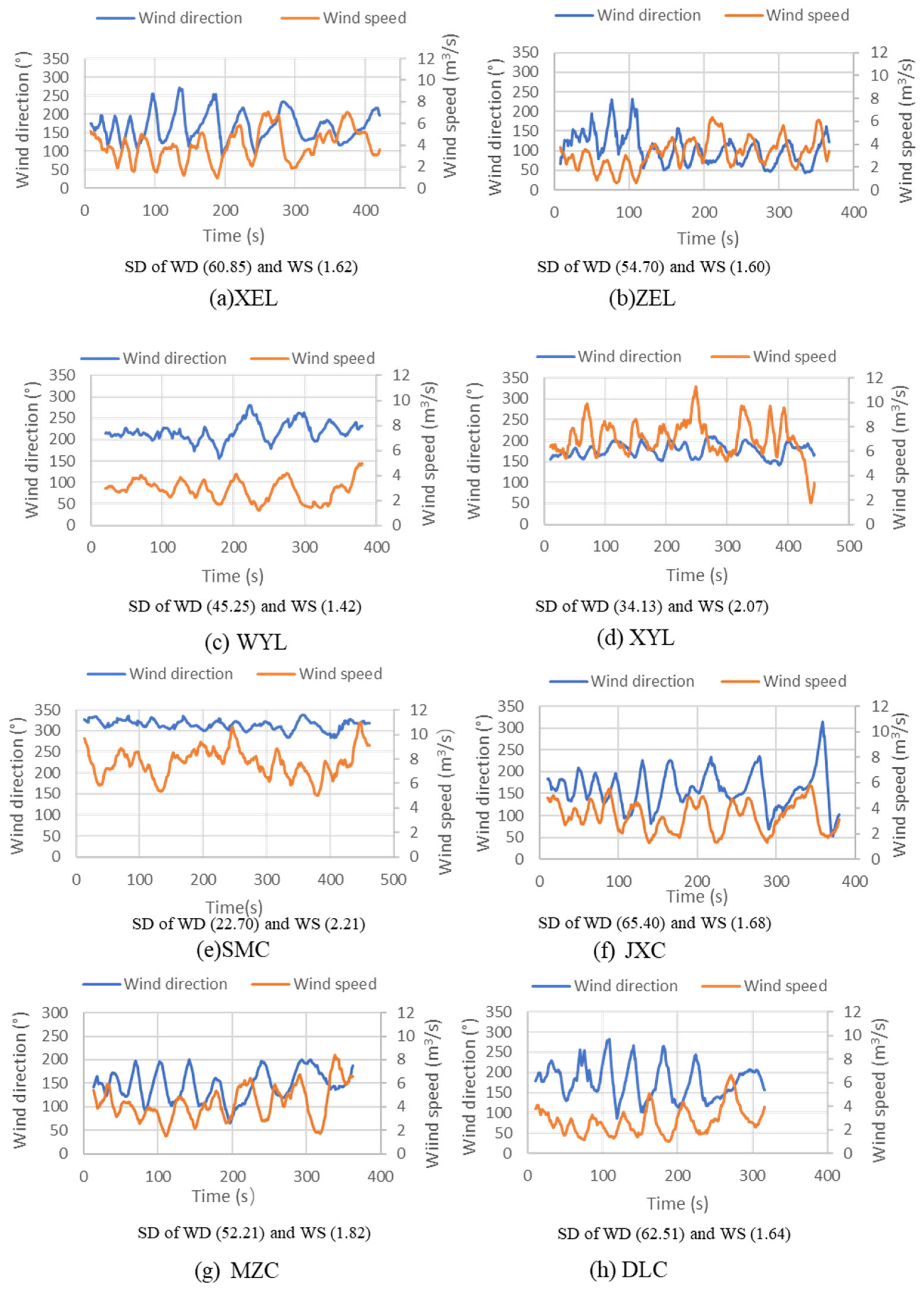
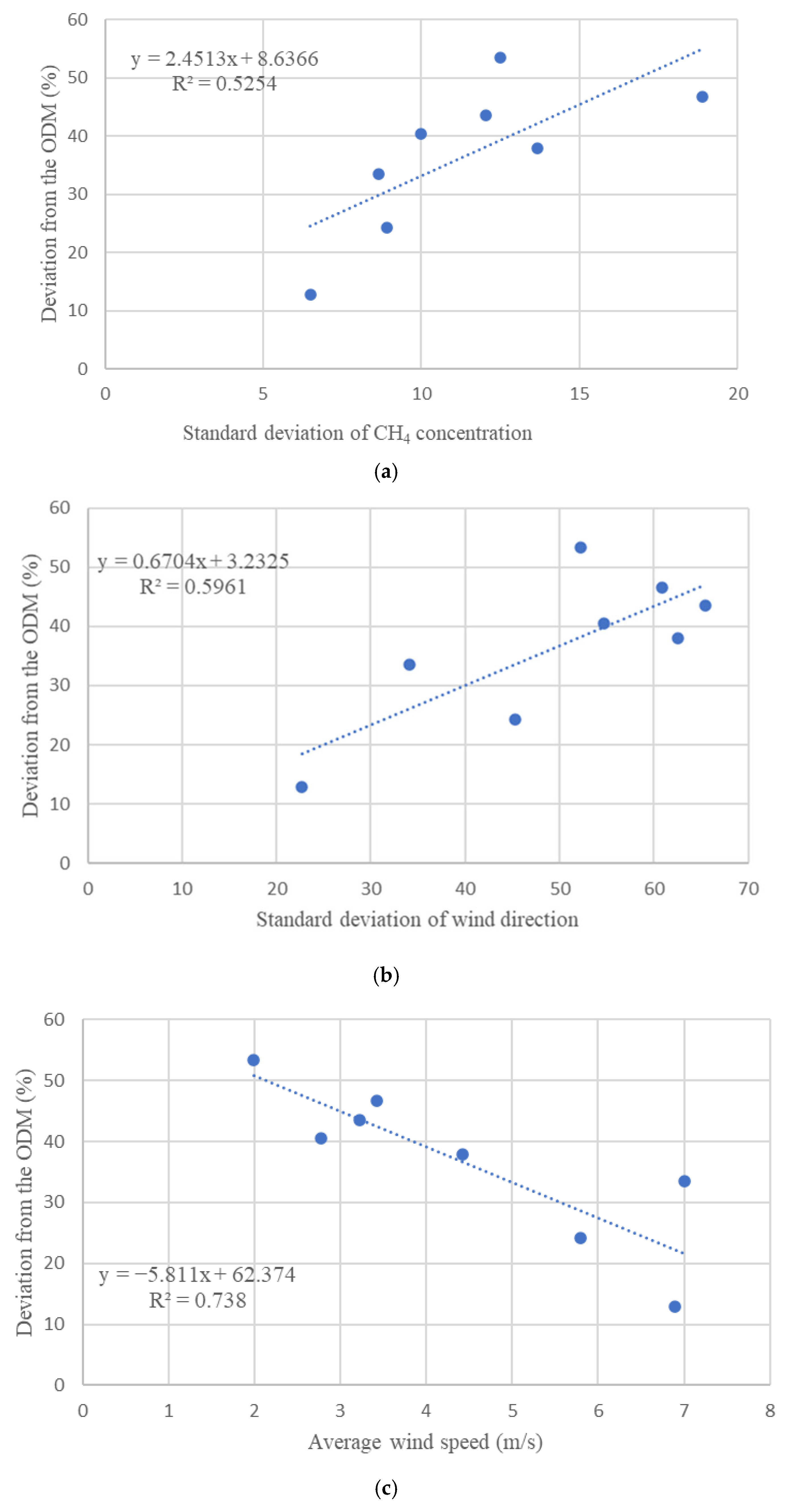
| Well Site | UAV Method | ODM Method | Absolute Value of Difference (%) | ||||
|---|---|---|---|---|---|---|---|
| Tank Leakage | Heating Furnace Emissions | Leakage at Sealing Points | Open Liquid Surface Leakage | Total | |||
| XEL | 1.184 | 0.252 | 0.0 | 0.517 | 0.003 | 0.772 | 53.4 |
| ZEL | 1.910 | 1.331 | 0.0 | 0.0 | 0.0001 | 1.331 | 43.5 |
| QSJ | Not detected | 0.0 | 0.0 | 0.005 | 0.0 | 0.005 | / |
| WYL | 1.152 | 0.917 | 0.0 | 0.0 | 0.011 | 0.927 | 24.2 |
| XYL | 2.035 | 1.833 | 0.0 | 0.0 | 0.009 | 1.843 | 10.5 |
| SMC | 0.486 | 0.557 | 0.0 | 0.0 | 0.001 | 0.558 | −12.8 |
| JXC | 3.209 | 2.090 | 0.0 | 0.0 | 0.009 | 2.091 | 53.5 |
| MZC | 0.787 | 0.536 | 0.0 | 0.0 | 0.004 | 0.537 | 46.7 |
| DLC | 0.632 | 0.0 | 0.0 | 0.267 | 0.002 | 0.267 | 48.0 |
| S6-5 | Not detected | 0.0 | 0.0 | 0.007 | 0.0 | 0.007 | / |
| S36-7 | Not detected | 0.0 | 0.0 | 0.002 | 0.0 | 0.002 | / |
| Average | 1.425 | 0.683 | 0.0 | 0.073 | 0.002 | 0.758 (1.061 a) | 33.4 |
| Well Site | CH4 Emission Rate (kg/h) | Uncertainty by CH4 Concentration (kg/h) | Percentage (%) | Uncertainty by Wind Speed and Direction (kg/h) | Percentage (%) |
|---|---|---|---|---|---|
| XEL | 1.184 | ±0.338 | 28.6 | ±0.257 | 21.7 |
| ZEL | 1.910 | ±0.787 | 41.2 | ±0.340 | 17.8 |
| WYL | 1.152 | ±1.540 | 133.7 | ±0.212 | 18.4 |
| XYL | 2.035 | ±1.055 | 51.8 | ±0.291 | 14.3 |
| SMC | 0.486 | ±0.523 | 107.6 | ±0.115 | 23.8 |
| JXC | 3.209 | ±3.913 | 121.9 | ±0.594 | 18.5 |
| MZC | 0.787 | ±0.821 | 104.3 | ±0.250 | 31.7 |
| DLC | 0.632 | ±0.797 | 126.2 | ±0.258 | 40.9 |
| Average | 1.425 | ±1.222 | 89.4 | ±0.290 | 23.4 |
Disclaimer/Publisher’s Note: The statements, opinions and data contained in all publications are solely those of the individual author(s) and contributor(s) and not of MDPI and/or the editor(s). MDPI and/or the editor(s) disclaim responsibility for any injury to people or property resulting from any ideas, methods, instructions or products referred to in the content. |
© 2025 by the authors. Licensee MDPI, Basel, Switzerland. This article is an open access article distributed under the terms and conditions of the Creative Commons Attribution (CC BY) license (https://creativecommons.org/licenses/by/4.0/).
Share and Cite
Xu, D.; Wang, C.; Gu, T.; Long, Z.; Luan, H.; Tang, Z.; Wang, X.; Liu, Y. An Unmanned Aerial Vehicle (UAV)-Based Methane Quantification Method for Oil and Gas Sites. Drones 2025, 9, 785. https://doi.org/10.3390/drones9110785
Xu D, Wang C, Gu T, Long Z, Luan H, Tang Z, Wang X, Liu Y. An Unmanned Aerial Vehicle (UAV)-Based Methane Quantification Method for Oil and Gas Sites. Drones. 2025; 9(11):785. https://doi.org/10.3390/drones9110785
Chicago/Turabian StyleXu, Degang, Chen Wang, Tao Gu, Zi Long, Hui Luan, Zhihe Tang, Xuan Wang, and Yinfei Liu. 2025. "An Unmanned Aerial Vehicle (UAV)-Based Methane Quantification Method for Oil and Gas Sites" Drones 9, no. 11: 785. https://doi.org/10.3390/drones9110785
APA StyleXu, D., Wang, C., Gu, T., Long, Z., Luan, H., Tang, Z., Wang, X., & Liu, Y. (2025). An Unmanned Aerial Vehicle (UAV)-Based Methane Quantification Method for Oil and Gas Sites. Drones, 9(11), 785. https://doi.org/10.3390/drones9110785





